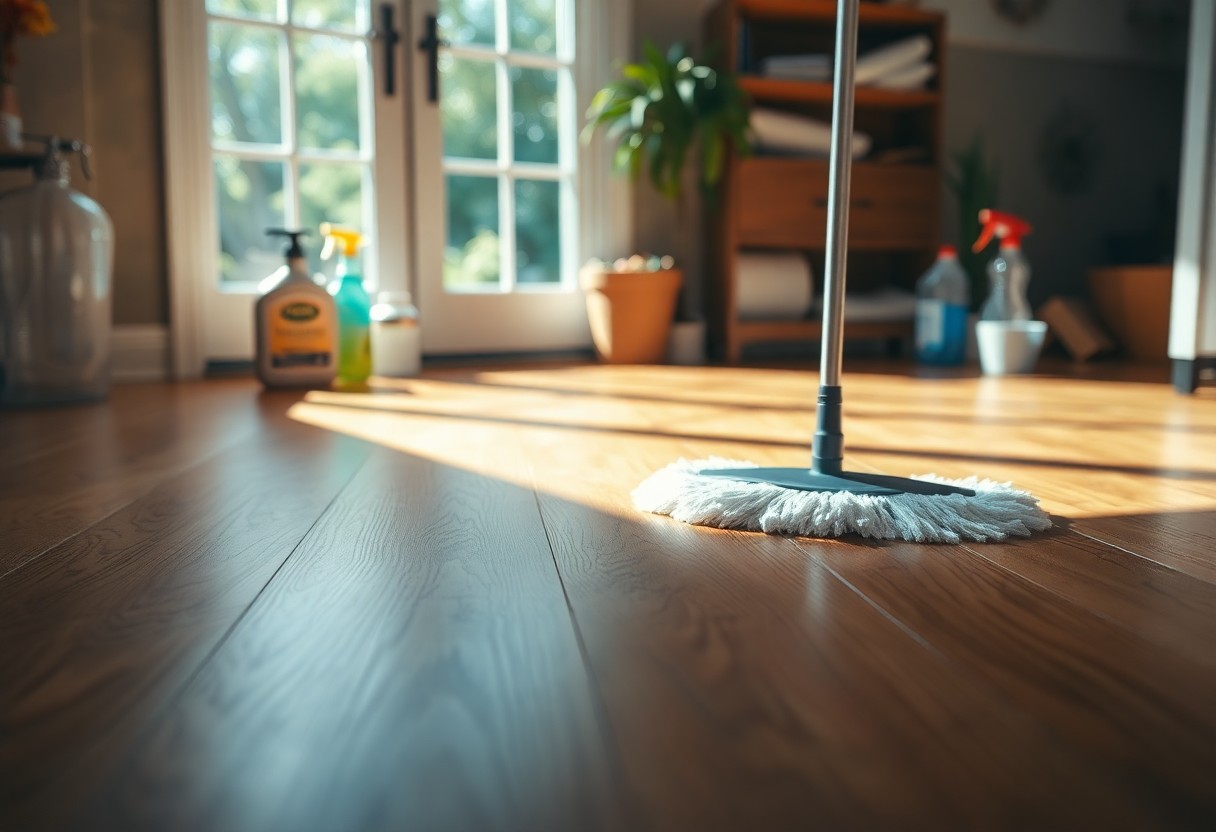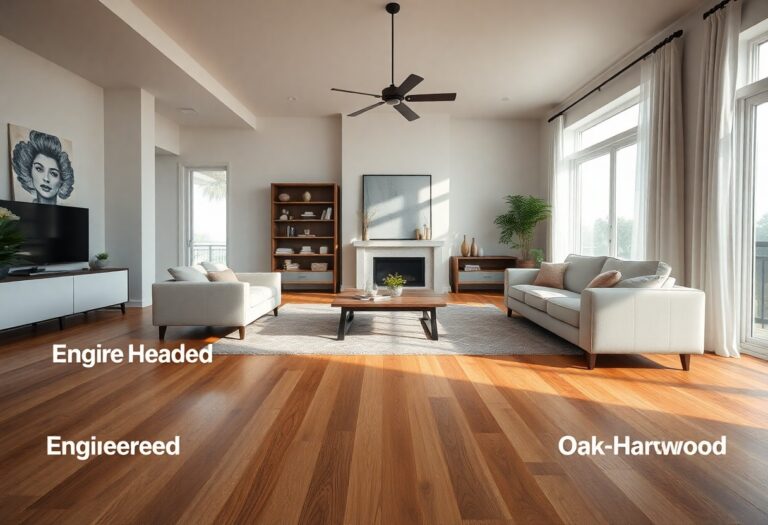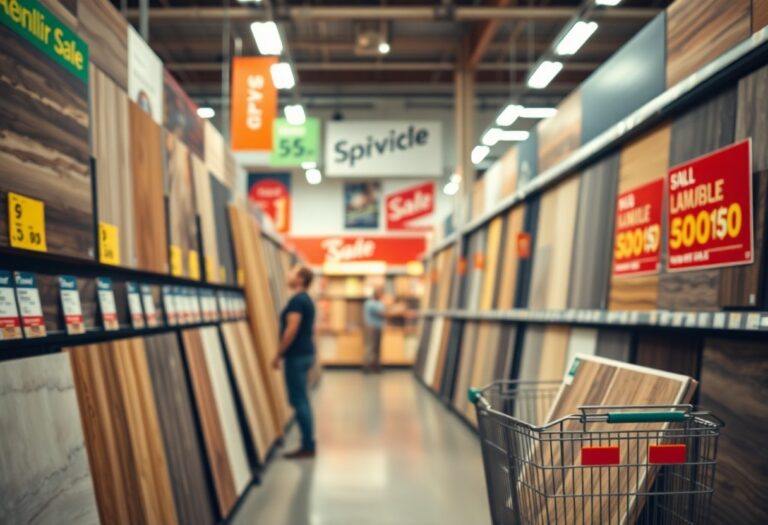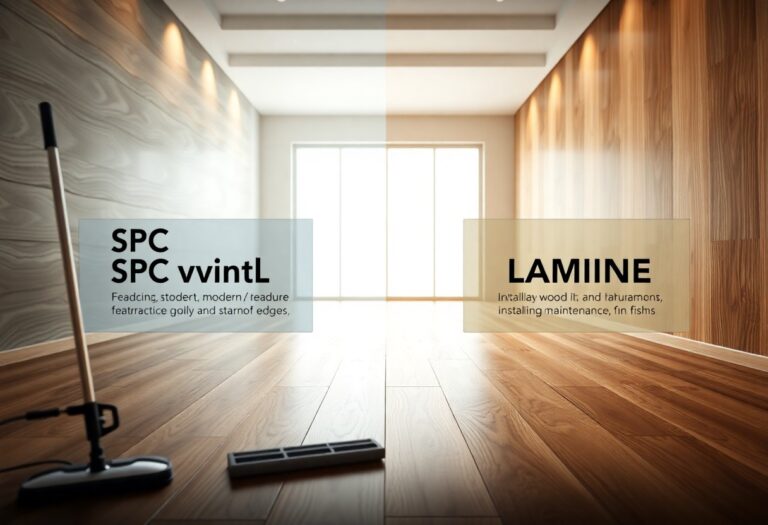Flooring maintenance is vital for keeping your laminate surfaces looking their best. You want to ensure that your floors maintain their durability and appeal over time. This informative guide will provide you with imperative tips to help protect your investment from scratches, moisture, and warping. By following these guidelines, you can help preserve the luster and strength of your laminate flooring, ensuring it continues to enhance your home for years to come.
Key Takeaways:
- Regular Cleaning: Keep your laminate flooring looking pristine by using a gentle cleaner and a soft cloth or a damp mop to avoid scratches.
- Avoid Excess Water: Laminate flooring is not waterproof, so it’s important to prevent water from pooling during cleaning to maintain its integrity.
- Use Protective Mats: Place mats at entryways and high-traffic areas to reduce wear and tear, helping to preserve the beauty of your flooring.
Understanding Laminate Flooring
What is Laminate Flooring?
The term laminate flooring refers to a multi-layer synthetic flooring product that is designed to resemble wood, stone, or other natural materials. At its core, laminate is constructed from a high-density fiberboard (HDF) core, which provides stability, durability, and comfort underfoot. This core is then topped with a decorative layer that showcases a variety of designs and textures to mimic real wood or stone, and finally finished off with a protective wear layer that guards against scratches, stains, and fading. This layered composition not only achieves a visually appealing result but also enhances the material’s longevity in high-traffic areas.
Another important aspect of laminate flooring is its ease of installation. The majority of laminate products feature a click-lock system, allowing you to easily fit the planks together without the need for glue or nails. This makes it a popular choice for DIY enthusiasts who appreciate the convenience of a floating floor that can be laid directly over most existing surfaces. Additionally, laminate flooring is lightweight and manageable, further easing the installation process and allowing for quick renovations in your living space.
Furthermore, laminate flooring is designed to offer more than just surface beauty. As a synthetic material, it is engineered to withstand the wear and tear that often accompanies household living. Many options on the market come with a moisture-resistant core, making them suitable for spaces that might experience occasional spills or humidity, such as kitchens and bathrooms. This combination of aesthetic appeal, ease of installation, and durability makes laminate flooring a wise choice for both homeowners and renters looking to enhance their interiors.
Benefits of Choosing Laminate Flooring
Laminate flooring has risen in popularity due to its numerous advantages that cater to modern lifestyles. Laminate offers affordability without compromising on appearance, as it provides the look of natural materials for a fraction of the cost. This makes it an ideal choice for individuals on a budget who still want to create a stylish home. With many styles and textures available, it is easy to find a laminate product that matches your sense of design, whether you prefer sleek, contemporary finishes or rustic, farmhouse aesthetics.
Another significant benefit of choosing laminate flooring is its remarkable resilience. The wear layer of laminate is engineered to withstand scratches, stains, and fading from sunlight, ensuring that your flooring retains its beauty for years to come. This level of durability is especially beneficial in homes with pets or children, where typical wear and tear can take its toll on traditional flooring options. Additionally, laminate flooring is easy to maintain, requiring only regular sweeping and occasional mopping to keep it looking its best.
Lastly, laminate flooring is a product of eco-conscious design. Many manufacturers use recycled materials in the production of laminate flooring, making it a more sustainable choice compared to solid hardwood. Aside from eco-friendliness, the installation process generates less waste than traditional flooring methods, and the long-lasting nature of laminate means you won’t have to replace it as frequently, contributing to lower overall consumption. This combination of practicality, beauty, and environmental responsibility makes laminate flooring a solid investment for your home.
And, with its affordable price point, durability, and wide array of designs, laminate flooring is a strategic choice for stylish living spaces and a wonderful step towards creating a home that reflects your personality.
Common Myths About Laminate Flooring
Common misconceptions about laminate flooring can often deter people from considering it as a viable flooring option. One prevalent myth is that laminate flooring is of lower quality compared to hardwood. However, you should know that modern laminate flooring is crafted with high-quality materials that offer durability and aesthetic appeal. Many laminate products are designed to replicate the appearance of real wood and carry warranties that attests to their resilience. What’s more, laminate can outlast some traditional wood floors in terms of wear resistance.
Another widespread belief is that laminate flooring is not suitable for moisture-prone areas. While it is true that older laminate products were not designed for bathrooms or kitchens, advancements in technology have led to the creation of moisture-resistant and waterproof options in today’s market. As a result, you can confidently install laminate flooring in these spaces without the fear of warping or water damage. It’s important to consult with your supplier when selecting laminate, ensuring you choose products specifically rated for these environments.
Finally, some people think that laminate flooring cannot be repaired if it becomes scratched or damaged. In reality, while it is true that laminate floors are not as easily refinished as hardwood, most scratches and scuffs can be addressed with simple touch-up kits or by replacing individual planks if necessary. By maintaining your laminate flooring with proper care techniques and addressing any surface issues promptly, you can keep it looking beautiful for years to come.
Flooring is not a one-size-fits-all situation, and it is necessary to base your decisions on accurate information rather than myths. Embrace laminate for its value and functionality, knowing that you are making a sensible choice for your home.
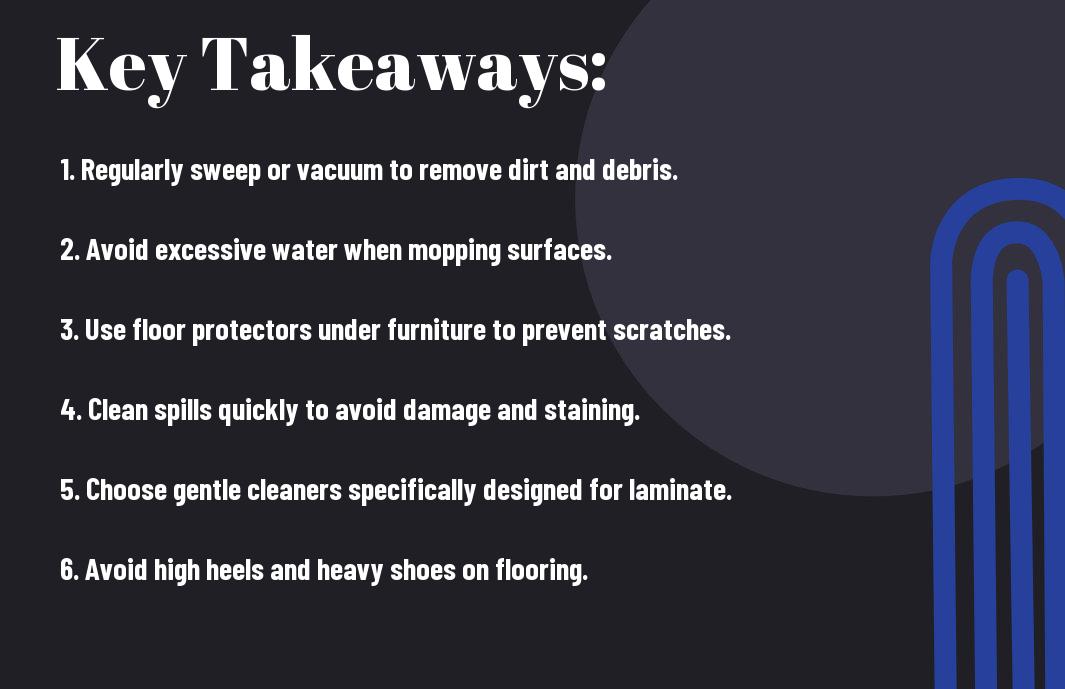
Daily Cleaning Routine
Best Practices for Regular Cleaning
Cleaning your laminate flooring regularly is vital for maintaining its beauty and longevity. You should start by sweeping or vacuuming your floors daily to remove dirt and debris. This practice not only keeps your floors looking pristine but also prevents scratches that can occur from dirt particles being ground into the surface. Using a soft-bristle broom or a vacuum cleaner with a hard floor setting is advisable to avoid damaging the laminate. Take care to pay extra attention to high-traffic areas, where dirt can accumulate more readily.
After sweeping or vacuuming, you can do a deeper clean 1-2 times a week. For this, using a damp mop with a mild laminate floor cleaner can effectively lift any remaining grime. Ensure that the mop is only slightly damp—excess water can seep into the seams of the laminate, leading to swelling and warping, which is something you definitely want to avoid. When mopping, employ a side-to-side motion instead of a circular motion in order to thoroughly clean the entire floor without missing spots.
Lastly, avoid using harsh cleaners, wax products, or steam mops on laminate flooring, as these can dull the finish and damage the floor over time. Instead, opt for products specifically designed for laminate care. If you ever spill a liquid on your floor, it is best to wipe it up immediately to prevent any potential staining or lasting damage. By following these cleaning best practices, you can ensure that your laminate floors maintain their original charm and look their best for years to come.
Tools and Products to Use
Along with establishing a regular cleaning routine, choosing the right tools and products is equally important for your laminate flooring care. A soft-bristle broom or vacuum designed for hard floors is vital for day-to-day maintenance. When mopping, look for a microfiber mop as it is gentler on the floor and provides an effective clean without scratching the surface. A mop with a removable, machine-washable pad makes it easy to keep your cleaning supplies fresh and hygienic.
For cleaning solutions, select a product that is specifically made for laminate floors. Avoid excessive use of water and always adhere to the manufacturer’s recommendations regarding cleaners. You can create a simple cleaning solution by mixing water with a small amount of vinegar or rubbing alcohol. Be sure to always test any cleaner in an inconspicuous area first to ensure it does not harm your flooring. Your goal is to choose products that leave your floors shining without causing any detrimental effects.
This attention to detail in selecting your cleaning tools and products will go a long way in preserving the life of your laminate flooring. Investing in quality cleaning supplies ensures a more effective clean while safeguarding your investment in laminate. Over time, professional-grade products can actually be cost-effective as they minimize the wear and tear on your floors, extending their lifespan.
Frequency of Cleaning
Cleaning your laminate flooring should be a consistent part of your routine to maintain its attractive appearance. Ideally, you should sweep or vacuum daily, especially in areas with heavy foot traffic. This frequent maintenance helps keep dust, dirt, and debris at bay, ensuring they don’t become embedded in the floor’s surface. A deeper clean with a damp mop should be done at least once a week to tackle any grime that may have settled in.
The frequency may vary depending on your household; if you have pets or children, you might find yourself needing to clean more frequently. Additionally, during particularly muddy or snowy seasons, it may be wise to increase the frequency of your cleaning sessions. Staying proactive about cleaning not only improves the look and feel of your floors but also extends their life by minimizing wear from dirt and debris.
Even with a busy schedule, it is beneficial to remember that maintaining a consistent cleaning frequency will yield positive results. Scheduling a short, daily cleaning can be a simple ritual that maintains your floor’s stunning appearance and overall health. By committing to this practice, you will be able to enjoy the beauty of your laminate flooring for many years to come.

Deep Cleaning Techniques
Not all cleaning sessions are created equal, and understanding when to probe a deep cleaning routine for your laminate flooring is important.
Identifying When Deep Cleaning is Necessary
The signs that your laminate flooring requires deep cleaning can often be subtle but significant. Look for signs such as a noticeable build-up of dirt or grime in the corners, scratches that have collected debris, or areas that seem to absorb moisture rather than repel it. Over time, even the best-maintained laminate can lose its luster, signaling that it may be time for a thorough clean to restore its shine and overall health. Pay close attention to high-traffic areas where dirt and oils accumulate from foot traffic; these spots may indicate that a deep cleaning is overdue.
Additionally, consider the overall appearance of your laminate. If it appears dull or has lost its original vibrancy, a deep cleaning may be your best solution. This can happen due to a combination of dirt, dust, and even residue from cleaning products that can dull the surface. Before jumping into a deep cleaning, assess whether regular maintenance has been neglected in recent weeks, as this can help you gauge how extensive your cleaning efforts should be.
Lastly, seasonality can also play a role in determining when deep cleaning is necessary. During spring and fall, households often produce more dirt and allergens due to changes in weather, making it an ideal time to implement a deep cleaning routine. By keeping an eye on these signs and aligning your cleaning efforts with seasonal changes, you can maintain the beauty and functionality of your laminate flooring.
Safe Cleaning Solutions for Laminate
Pertaining to maintaining your laminate flooring, using the right cleaning solutions is key to preserving its integrity. Avoid harsh chemicals that can strip away the protective finish and dull the surface. Instead, opt for gentle, safe alternatives that are effective in breaking down dirt without causing damage. White vinegar diluted in water is a popular choice, as it not only cleans but also neutralizes odors. Additionally, you can find commercially available laminate floor cleaners specifically formulated to tackle tough stains without harming the floor.
You may also consider using a mixture of dish soap and water, which is another gentle yet effective solution for routine cleaning. Be sure to use a soft microfiber mop to apply your cleaning solution, as this will help avoid scratches while still ensuring a thorough clean. Experimenting with different solutions will help you find what works best for your laminate flooring while ensuring you don’t introduce elements that could harm it.
It’s also beneficial to periodically inspect the cleaning products you use, ensuring they are clearly marked as safe for laminate or approved by your flooring manufacturer. By doing so, you will safeguard your investment and maintain the aesthetic appeal of your flooring for years to come.
Step-by-Step Deep Cleaning Process
Against the backdrop of routine cleaning, a structured deep cleaning process will help bring out the best in your laminate flooring. Follow these steps to ensure an effective and safe cleaning experience.
| Step | Action |
|---|---|
| 1 | Remove furniture and items from the floor. |
| 2 | Vacuum or sweep the area thoroughly to remove dirt and debris. |
| 3 | Prepare your cleaning solution (e.g., water and vinegar or laminate cleaner). |
| 4 | Use a microfiber mop to apply the solution, starting in a corner and moving towards the exit. |
| 5 | Allow the floor to dry completely; avoid walking on it until dry. |
Safe usage of your laminate cleaning solutions is vital. After you complete your deep cleaning, inspect the flooring for any areas that might require additional attention. If needed, repeat the process in spots that still appear dirty. This systematic approach not only enhances the beauty of your laminate flooring but also extends its lifespan, allowing you to enjoy it fully for years ahead.
Preventive Maintenance
After you have installed your laminate flooring, maintaining its beauty requires some thought and effort. Preventive maintenance is important for extending the life of your floors and ensuring they remain in pristine condition. In this section, we will explore key strategies for protecting your floors and managing the environment around them effectively.
Protecting Your Floors from Scratches
Between high foot traffic, heavy furniture, and the occasional pet movement, scratches on your laminate flooring can become a common issue. To combat this, consider placing felt pads or rubber coasters under furniture legs. These simple additions can significantly reduce the likelihood of scratches caused by shifting heavy furniture or even when you’re entertaining guests. Regularly check and replace these pads as needed, ensuring they remain effective in their protective role.
Furthermore, be mindful of the footwear worn in your home. Shoes with hard soles or high heels can contribute to surface scratches. Encourage family members and guests to remove their shoes upon entering your home or at the very least, designate certain areas for shoe-wearing. Additionally, you can provide cozy slippers to encourage a relaxed, scratch-free environment.
Lastly, regular maintenance, such as sweeping and vacuuming to eliminate grit and dirt, is important. When dirt settles on your laminate floors, it can act like sandpaper, causing scratches over time. Implement a routine cleaning schedule to keep your floors free from dust and debris. With consistent attention to these details, you can maintain the beauty of your laminate floors for years to come.
Managing Humidity and Temperature
Among the major environmental factors that can affect your laminate flooring are humidity and temperature. Laminate flooring is primarily made from compressed wood fibers and can be sensitive to substantial fluctuations in moisture and heat. Keeping your home’s environment stable is key to preventing warping, buckling, or gaps from forming in your flooring.
One effective way to manage these conditions is by using a hygrometer to monitor humidity levels, ideally keeping them between 30-50%. If your home tends to be on the humid side, using a dehumidifier can help regulate moisture levels. Conversely, in dry environments, consider using a humidifier to introduce moisture back into the air. This creates a more balanced atmosphere for your flooring, reducing the risk of damage.
Temperature also plays a vital role in maintaining your laminate flooring’s integrity. Ideally, you should keep your home’s temperature reasonably consistent, avoiding extreme heat or cold. It’s best to maintain temperatures around 60-80°F to ensure that your laminate flooring doesn’t expand too much in the summer heat or contract during winter chills. Making use of smart thermostats could add an extra layer of control over your home’s environment.
Humidity and Temperature Management
| Recommended Humidity Levels | 30-50% |
| Ideal Temperature Range | 60-80°F |
Managing these conditions significantly impacts your laminate floor’s longevity and aesthetic charm. Paying close attention to humidity levels and temperature can help you catch potential issues early, saving you time and money in the long run.
The Importance of Area Rugs and Mats
Among the most effective methods for protecting your laminate flooring is the strategic use of area rugs and mats. Placing these items in high-traffic areas, such as entryways or hallways, can absorb impacts and minimize the risk of scratches or dents over time. These floor coverings not only serve as a protective barrier but can also enhance the overall design of your space, creating a warm and inviting atmosphere.
It’s important to choose rugs and mats that are safe for use on laminate flooring. Opt for those with non-slip backing to prevent any slipping issues and ensure they remain securely in place. Additionally, make sure that the materials used for your rugs do not retain moisture, as trapped water can lead to damaging mold or mildew growth underneath.
Regularly cleaning your rugs will also help maintain their visual appeal and functionality. Vacuuming both your rugs and your laminate floors will help remove dirt and debris that can cause wear over time. This practice helps create a clean home environment, ensuring that both your rugs and your laminate flooring remain in excellent condition.
Considering the significant benefits that area rugs and mats provide, they should be a staple in your laminate flooring maintenance strategy. They elevate your home’s aesthetic while adding much-needed protection.
Repairing Scratches and Damage
Many laminate floor owners find that despite their best efforts, scratches and damage can occur over time. Understanding how to effectively identify the type of damage is vital for determining the best approach to restoration. Damage types can range from superficial scratches to deeper gouges that may require more intensive repair. By familiarizing yourself with the different manifestations of wear and tear, you can maintain the aesthetic appeal of your flooring for years to come.
Identifying Types of Damage
Identifying damage on your laminate flooring is the first step in maintaining its beauty and longevity. Superficial scratches are often caused by pets, furniture, or even daily foot traffic. These marks typically affect only the surface of the laminate and can be easily addressed with minimal effort. In contrast, deep scratches penetrate through the top layer, exposing the core material of the laminate and may require more extensive repair techniques. Lastly, gouges or chips can occur from heavy impacts or dropped objects, leading to extensive aesthetic and structural concerns that must be tackled promptly.
| Type of Damage | Description |
|---|---|
| Superficial Scratches | Minor surface damage easily fixed. |
| Deep Scratches | Penetrates the top layer requiring more work. |
| Gouges or Chips | Significant impact-related damage needing urgent repair. |
| Discoloration | Fading or staining due to exposure to sunlight or spills. |
| Water Damage | Causes warping or swelling, usually from leaks. |
Any laminate floor owner can benefit from being aware of these types of damage as it empowers you to take the necessary action to preserve the beauty of your flooring.
DIY Repair Solutions for Minor Issues
To handle minor scratches and damage, DIY repair solutions can often be your best line of defense. For superficial scratches, a simple method involves using a laminate floor repair kit, which typically includes a wax pencil or marker that closely matches your flooring color. This allows you to fill in the scratch with ease, restoring the finish. For deep scratches, you can utilize a combination of wood filler and a touch-up marker – first filling the scratch and then coloring it to blend seamlessly with the surrounding area.
Identifying when to apply these fixes is integral to preserving the look of your floors. Make it a habit to regularly inspect your laminate for signs of wear and promptly address any minor issues to prevent them from developing into larger, more complicated repairs. Additionally, maintaining your floors diligently prevents significant wear and tear that could lead to more serious damage down the line.
Types of damage should not be ignored, as seemingly minor scratches and dents can lead to larger issues if not promptly treated. You can often find many effective repair solutions at your local hardware store or online, allowing you to act swiftly and easily. These materials are generally user-friendly, making them suitable for anyone, regardless of experience, to achieve satisfying results.
When to Call a Professional
Damage to your laminate flooring may sometimes exceed the limits of DIY repair solutions, indicating that it is time to call a professional. Serious issues, such as water damage or extensive gouges, can compromise the integrity of your floor, leading to potential safety hazards. Professionals have the skills and tools at their disposal to address these underlying problems, ensuring repairs are conducted seamlessly and effectively. Ignoring significant damage can lead to further deterioration, eventually requiring even more costly repairs or a full replacement of your flooring.
Indeed, understanding when to seek professional help can save you time and money in the long run. If your laminate floors exhibit extensive discoloration, swelling, or large areas of damage that cannot be remedied with DIY methods, it’s wise to consult with a flooring professional. They are trained to assess the condition of your floors accurately and provide tailored solutions that align with the best practices for your specific flooring material.

Long-Term Care and Maintenance
Now, maintaining your laminate flooring properly will ensure that it remains beautiful and durable over time. One of the most effective ways to achieve this is by frequently cleaning it with the right products to prevent dirt and debris buildup, which can lead to scratches and dullness. In addition, placing protective mats at entry points can safeguard against dirt, sand, and moisture that might be tracked in. Furthermore, it’s important to avoid using abrasive cleaning agents and tools, as these can damage the surface coating of your laminate.
How to Extend the Lifespan of Your Laminate
Extend your laminate flooring’s longevity by adopting a mindful approach to its care. First and foremost, establish a cleaning routine that includes sweeping or vacuuming regularly to eliminate particles that can scratch the surface. Afterward, use a damp mop with a cleaner specifically designed for laminate to refresh the flooring without soaking it, as excessive moisture can lead to warping. Additionally, keep an area rug in high-traffic zones to mitigate wear and tear.
Another effective method to prolong the life of your laminate is to manage humidity levels in your home. Your laminate flooring performs best in a controlled environment, ideally between 30% and 50% humidity. Overly dry conditions can cause your laminate to expand and contract, which can lead to gaps, while excessive moisture can seep into the joints and cause significant damage. Using a humidifier in dry conditions or a dehumidifier in humid conditions will help maintain a stable atmosphere.
Lastly, be mindful of furniture placement and movement. Use floor protectors under the legs of heavy furniture to prevent indentations, and try to lift rather than drag furniture when rearranging. This practice will prevent scratches and help maintain an even surface. By investing time and effort into these simple yet effective strategies, you will significantly extend the lifespan of your beautiful laminate flooring.
Recommendations for Replacing Flooring
Between regular wear and tear, environmental conditions, and unforeseen accidents, there may come a time when you need to consider replacing your laminate flooring. It’s important to assess the condition of your floor regularly and be aware of signs indicating that replacement might be necessary. Look for deep scratches, extensive fading, and water damage; these issues can greatly affect your flooring’s appearance and functionality.
Replacing laminate flooring typically involves more than just swapping out the surface materials. Ensure you assess your subfloor’s condition, as a damaged subfloor can lead to complications in installation and drainage. Depending on your skill level, you can choose to hire a professional for installation; however, many laminate flooring options today come with easy-to-follow installation guides, allowing homeowners to tackle DIY projects with minimal hassle. Moreover, it’s always wise to research the warranty provided with your chosen flooring, ensuring longevity and protecting your investment.
Laminate flooring can last anywhere from 15 to 25 years, but knowing when to replace it is key. When you notice significant wear or structural issues that can’t be easily resolved, consider opting for new laminate flooring. Prioritize high-quality materials to ensure your new installation provides the look and durability you desire while enhancing the aesthetic of your space.
Seasonal Maintenance Tips
Extend the life of your laminate flooring by incorporating seasonal maintenance tips into your routine. As the seasons change, so do the demands placed on your flooring. In the winter, prevent water and ice damage by placing mats both inside and outside entryways to absorb moisture. In summer, increased dust and pollen can accumulate, necessitating more frequent sweeping or vacuuming. Adjust your cleaning schedule seasonally to ensure your laminate remains in top condition all year long.
- Utilize a moisture barrier in winter months
- Use area rugs to protect high-traffic zones
- Check for scratches during seasonal changes
- Maintain humidity levels throughout the year
- Opt for a gentle cleaning solution to avoid damage
Assume that adhering to these seasonal maintenance tips will not only keep your laminate floor looking pristine but also support its performance over time. By paying attention to the unique needs of your flooring during different seasons, you’ll ensure that it continues to impress for many years.
Care for your laminate flooring is about more than just cleaning; it requires a consistent effort and awareness of environmental changes. Implementing maintenance strategies tailored to seasonal shifts will pay off in preserving both the form and function of your flooring. You’ll not only enhance the aesthetic appeal of your home but also enjoy the practical benefits of a well-maintained laminate surface. Assume that with the right approach, your laminate floor can remain a stunning feature of your home for an extended period.
- Assess the environmental conditions regularly
- Utilize cleaning products that are safe for laminate
- Ensure continuous airflow to prevent moisture buildup
Assume that embracing a proactive stance towards seasonal care will ultimately yield remarkable results, transforming routine maintenance into a pleasurable experience that enhances your home’s overall atmosphere.
Conclusion
Now that you have explored the imperative tips for maintaining your laminate flooring, you can confidently implement these practices to prolong the beauty and functionality of your investment. Regular cleaning is key to avoiding dirt and grime buildup, which can detract from the appearance of your floors. By utilizing the right tools, such as a dry mop or a vacuum with a soft attachment, you can effectively remove dust and debris without causing scratches. When routine cleaning is complemented by periodic deep cleaning, you can ensure that your laminate floors continue to sparkle and shine, enhancing the overall aesthetic of your home.
You should also be aware of the impact environmental factors have on the longevity of your laminate flooring. Taking steps to manage humidity levels in your home will help prevent warping or buckling. Using area rugs or mats in high-traffic zones is an additional method to shield your floors from excessive wear and tear. You should also be cautious about choosing the right cleaning products. Opting for pH-balanced cleaners formulated specifically for laminate surfaces will keep your floors looking their best and protect their finish. Avoiding harsh chemicals and abrasive tools will certainly go a long way in preserving their luster.
Finally, staying attuned to any needed repairs and being proactive about addressing issues, such as scratches or dents, will contribute to the enduring beauty of your laminate flooring. Schedule routine inspections to identify areas requiring attention and act promptly to handle any concerns. By investing time in maintenance and employing best practices for care, you can enjoy the aesthetic and functional benefits laminate flooring brings to your living spaces for many years to come. With these tips in mind, you’re now equipped to maintain the beauty of your floors and create an inviting environment in your home.


